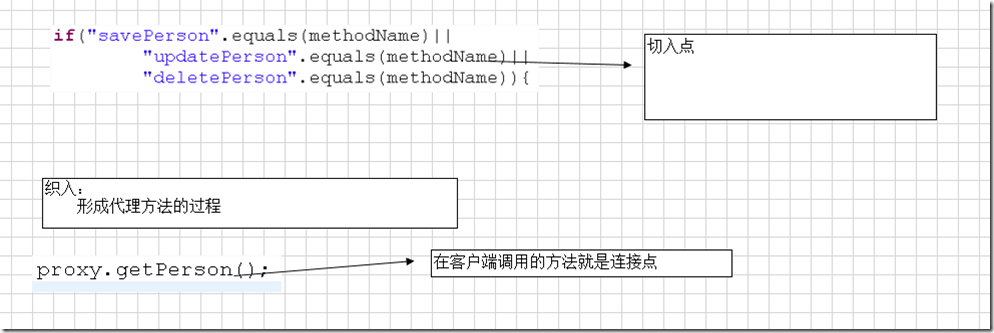Spring学习笔记
Spring 的控制反转:把对象的创建、初始化、销毁等工作交给Spring 容器来做,有spring容器控制对象的生命周期
applicationContext.xml
beans --->spring 容器中的类
alias—>取别名
不管有继承关系(不管有几层)先把当前类加载到虚拟机中才能创建对象,而在加载过程中,静态代码块(static )就一块执行了。所以
现在子类静态代码快赋值,在父类中(@before)接受并使用该值
无论两个类之间有什么继承关系,今天代码块比方法先执行。
--------------------------------------------------------------------------------------------------------------------------------------------------------
在默认情况下,Spring创建bean是单例模式,属性是共享的(线程安全问题)
bean scope属性--->singleton(单例,共享,默认)一般情况下,把数据存放在方法中的变量中,尽量别放在类的属性中\prototype(多例) 当一个bean是多例模式下,lazy-init为false或者default无效
init-method
* 该方法是由spring容器执行
* 在构造函数之后执行
* 如果在构造函数之后,在调用方法之前要做一些工作,可以在init方法中完成
destroy-method
* 如果该bean是单例,则在spring容器关闭或者销毁的时候,执行该方法
* 如果该bean是多例,则spring容器不负责销毁
说明:要想让spring容器控制bean的生命周期,那么该bean必须是单例
如果该bean是多例,该bean中还有资源,关闭资源的操作由程序员完成
在启动spring容器的时候,spring容器配置文件中的类就已经创建完成对象了
lazy-init
default false
true 在context.getBean的时候才要创建对象
* 优点
如果该bean中有大数据存在,则什么时候context.getBean,什么时候创建对象
可以防止数据过早的停留在内存中,做到了懒加载
* 缺点
如果spring配置文件中,该bean的配置有错误,那么在tomcat容器启动的时候,发现不了
false 在启动spring容器的时候创建对象
* 优点
如果在启动tomcat时要启动spring容器,
那么如果spring容器会错误,这个时候tomcat容器不会正常启动
* 缺点
如果存在大量的数据,会过早的停留在内存中
DI(依赖注入):给属性赋值 person类中name;
eg、
<?xml version="1.0" encoding="UTF-8"?>
<beans xmlns="http://www.springframework.org/schema/beans"
xmlns:xsi="http://www.w3.org/2001/XMLSchema-instance"
xsi:schemaLocation="http://www.springframework.org/schema/beans
http://www.springframework.org/schema/beans/spring-beans-2.5.xsd">
<bean id="person" class="cn.itcast.spring0909.di.xml.set.Person">
<!--
property就是代表属性
在spring中基本类型(包装类型和String)都可以用value来赋值
引用类型用ref赋值
-->
<property name="pid" value="5"></property>
<property name="pname" value="王二麻子"></property>
<property name="student">
<ref bean="student"/>
</property>
<property name="lists">
<list>
<value>list1</value>
<value>list2</value>
<ref bean="student"/>
</list>
</property>
<property name="sets">
<set>
<value>set1</value>
<value>set2</value>
<ref bean="student"/>
</set>
</property>
<property name="map">
<map>
<entry key="map1">
<value>map1</value>
</entry>
<entry key="map2">
<value>map2</value>
</entry>
<entry key="map3">
<ref bean="student"/>
</entry>
</map>
</property>
<property name="properties">
<props>
<prop key="prop1">
prop1
</prop>
</props>
</property>
</bean>
<bean id="student" class="cn.itcast.spring0909.di.xml.set.Student"></bean>
</beans>
构造函数:
<bean id="person" class="cn.itcast.spring0909.di.xml.constructor.Person">
<!--
构造函数的参数
index 第几个参数,下标从0开始
type 参数的类型
ref 如果类型是引用类型,赋值
value 如果类型是基本类型,赋值
说明:
只能指定一个构造函数
-->
<constructor-arg index="0" type="java.lang.String" value="干露露"></constructor-arg>
<constructor-arg index="1" ref="student"></constructor-arg>
</bean>
IOC和DI做了什么事情:
1、创建对象
2、为对象的属性赋值
意义在于:可以在一个类引用一个接口,而给接口赋值的工作交给spring容器来做,程序员只需在配置文件作相应的配置就好了,这样客户端就可以完全的面向接口的编程。
----------------------------------------------------------------------------------------------------------------------------------------------
annotation
@Resource注解
原理
* * 启动spring容器,并且加载配置文件
* * 会为student和person两个类创建对象
* * 当解析到<context:annotation-config></context:annotation-config>
* 会启动依赖注入的注解解析器
* * 会在纳入spring管理的bean的范围内查找看哪些bean的属性上有@Resource注解
* * 如果@Resource注解的name属性的值为"",则会把注解所在的属性的名称和spring容器中bean的id进行匹配
* 如果匹配成功,则把id对应的对象赋值给该属性,如果匹配不成功,则按照类型进行匹配,如果再匹配不成功,则报错
* * 如果@Resource注解的name属性的值不为"",会把name属性的值和spring容器中bean的id做匹配,如果匹配
* 成功,则赋值,如果匹配不成功 ,则直接报错
* 说明:
* 注解只能用于引用类型,如果一个类中有基本数据类型(long int String),并且基本类型使用Spring的形式赋值的,这个时候,该类必须用xml进行赋值(在javaweb中很少直接赋值,大多数都是从服务器获取值)
@component注解
原理
* * 启动spring容器,加载配置文件
* * spring容器解析到
* <context:component-scan base-package="cn.itcast.spring0909.scan"></context:component-scan>
* * spring容器会在指定的包及子包中查找类上是否有@Component
* * 如果@Component注解没有写任何属性
* @Component
* public class Person{
*
* }
* ==
* <bean id="person" class="..Person">
* 如果@Component("aa")
* @Component
* public class Person{
*
* }
* ==
* <bean id="aa" class="..Person">
* * 在纳入spring管理的bean的范围内查找@Resource注解
* * 执行@Resource注解的过程
* 说明:
* xml效率比较高,但是书写比较麻烦
* 注解效率比较低,书写比较简单
-------------------------------------------------------------------------------------------------------------------------------------
<!--
abstract
spring容器不会为该类创建对象
-->
<bean id="person" class="cn.itcast.spring0909.extend.Person" abstract="true">
<property name="name" value="王二麻子的哥"></property>
</bean>
--------------------------------------------------
<bean id="person" class="cn.itcast.spring0909.extend.Person" abstract="true">
<property name="name" value="王二麻子的哥"></property>
</bean>
<!--
parent
让子类拥有父类的属性的值
-->
<bean id="student" class="cn.itcast.spring0909.extend.Student" parent="person">
</bean>
代理模式、动态代理 (invoke)
package cn.itcast.salary.jdkproxy; import java.lang.reflect.InvocationHandler;
import java.lang.reflect.Method;
/**
* 1、把日志、安全性框架、权限导入进去
* 2、把目标类导入进去
* 3、上述两类通过构造函数赋值
* @author Administrator
*
*/
public class SalaryInterceptor implements InvocationHandler{ private Logger logger;
private Security security;
private Privilege privilege; private Object target; public SalaryInterceptor(Logger logger,Security security,Privilege privilege,Object target){
this.logger = logger;
this.security = security;
this.privilege = privilege;
this.target = target;
} @Override
public Object invoke(Object proxy, Method method, Object[] args)
throws Throwable {
// TODO Auto-generated method stub
System.out.println("aaaaaa");
this.logger.logging();
this.security.security();
if("admin".equals(this.privilege.getAccess())){
//调用目标类的目标方法
method.invoke(this.target, args);
}else{
System.out.println("您没有该权限");
}
System.out.println("bbbbbb");
return null;
} }
客户端
public void test(){
Logger logger = new Logger();
Privilege privilege = new Privilege();
privilege.setAccess("admin");
Security security = new Security();
SalaryManager target = new SalaryManagerImpl();
SalaryInterceptor interceptor = new SalaryInterceptor(logger, security, privilege, target);
/**
* 1、目标类的类加载器
* 2、目标类的所有的接口
* 3、拦截器
*/
SalaryManager proxy = (SalaryManager) Proxy.newProxyInstance(target.getClass().getClassLoader(), target.getClass().getInterfaces(), interceptor);
proxy.showSalary();//代理对象的代理方法
}
---------------------------------------------------------------------------------------------------------------


---------------------------------------------------------------------------------------------------------------------
AOP


说明:
* 切面
日志、安全性的框架、权限的检查等,总之和业务逻辑没有关系的都可以看做切面
* 通知
切面中的方法
* 切入点
只有符合切入点,才能把通知和目标方法结合在一起
* 连接点
客户端调用的方法
* 代理对象的方法=通知+目标方法
* aop:做到了代码块的重用
<?xml version="1.0" encoding="UTF-8"?>
<beans xmlns="http://www.springframework.org/schema/beans"
xmlns:aop="http://www.springframework.org/schema/aop"
xmlns:xsi="http://www.w3.org/2001/XMLSchema-instance"
xsi:schemaLocation="http://www.springframework.org/schema/beans
http://www.springframework.org/schema/beans/spring-beans-2.5.xsd
http://www.springframework.org/schema/aop
http://www.springframework.org/schema/aop/spring-aop-2.5.xsd">
<!--
1、引入AOP的命名空间
2、目标类
3、切面
4、拦截器 由spring内部实现
5、aop的配置
-->
<bean id="personDao" class="cn.itcast.spring0909.aop.xml.PersonDaoImpl"></bean>
<bean id="transaction" class="cn.itcast.spring0909.aop.xml.Transaction"></bean>
<!--
aop的配置
-->
<aop:config>
<!--
切入点表达式
expression
确定哪个类可以生成代理对象
id 唯一标识
-->
<aop:pointcut expression="execution(* cn.itcast.spring0909.aop.xml.PersonDaoImpl.*(..))" id="perform"/>
<!--
切面
-->
<aop:aspect ref="transaction">
<!--
前置通知
-->
<aop:before method="beginTransaction" pointcut-ref="perform"/>
<aop:after-returning method="commit" pointcut-ref="perform"/>
</aop:aspect>
</aop:config>
</beans>

------------------------------------------------------------------------------------------------------
<aop:config>
<!--
切入点表达式
expression
确定哪个类可以生成代理对象
id 唯一标识
-->
<aop:pointcut expression="execution(* cn.itcast.spring0909.aop.xml.PersonDaoImpl.*(..))" id="perform"/>
<!--
切面
-->
<aop:aspect ref="transaction">
<!--
前置通知
* 在目标方法执行之前
*
-->
<!--
<aop:before method="beginTransaction" pointcut-ref="perform"/>
-->
<!--
后置通知
* 在目标方法执行之后
* 可以根据returning获取目标方法的返回值
* 如果目标方法遇到异常,该通知不执行
-->
<!--
<aop:after-returning method="commit" pointcut-ref="perform" returning="val"/>
-->
<!--
前置通知和后置通知只能在目标方法文中添加内容,但是控制不了目标方法的执行
-->
<!--
最终通知
* 在目标方法执行之后
* 无论目标方法是否遇到异常,都执行
* 经常做一些关闭资源
-->
<!--
<aop:after method="finallyMethod" pointcut-ref="perform"/>
-->
<!--
异常通知
目的就是为了获取目标方法抛出的异常
-->
<aop:after-throwing method="exceptionMethod" throwing="ex" pointcut-ref="perform"/>
<!--
环绕通知
能控制目标方法的执行
-->
<aop:around method="aroundMethod" pointcut-ref="perform"/>
</aop:aspect>
</aop:config>
AOP总结:
* 原理
* * 加载配置文件,启动spring容器
* * spring容器为bean创建对象
* * 解析aop的配置,会解析切入点表达式
* * 看纳入spring管理的那个类和切入点表达式匹配,如果匹配则会为该类创建代理对象
* * 代理对象的方法体的形成就是目标方法+通知
* * 客户端在context.getBean时,如果该bean有代理对象,则返回代理对象,如果没有代理对象则返回原来的对象
* 说明:
* 如果目标类实现了接口,则spring容器会采用jdkproxy,如果目标类没有实现接口,则spring容器会采用
* cglibproxy
---------------------------------------------------------------------------------------------------------------------------------------------
Struts2
问题:
* action是单例还是多例?怎么样证明?
Action是多例的,在构造函数中输出一句话,如果请求好几次,只输出一次,单例
如果请求很多次,输出很多次,多例
* struts2有三个类
ActionContext
ServletActionContext 建立struts2与servlet的通信的桥梁
ActionInvocation struts2总的上下文
* struts2的数据都在值栈中,怎么样保证数据的安全性?值栈的生命周期是什么?
因为ValueStack在ActionContext中,而ActionContext在ThreadLoad中,所以可以保证数据的安全性
值栈的生命周期是一次请求,当前的action,actioncontext,valuestack的生命周期是一致的

--------------------------------------------------------------------------------------------------------


Spring学习笔记的更多相关文章
- 【Spring学习笔记-MVC-3.1】SpringMVC返回Json数据-方式1-扩展
<Spring学习笔记-MVC>系列文章,讲解返回json数据的文章共有3篇,分别为: [Spring学习笔记-MVC-3]SpringMVC返回Json数据-方式1:http://www ...
- spring学习笔记(一) Spring概述
博主Spring学习笔记整理大部分内容来自Spring实战(第四版)这本书. 强烈建议新手购入或者需要电子书的留言. 在学习Spring之前,我们要了解这么几个问题:什么是Spring?Spring ...
- Java框架spring 学习笔记(十八):事务管理(xml配置文件管理)
在Java框架spring 学习笔记(十八):事务操作中,有一个问题: package cn.service; import cn.dao.OrderDao; public class OrderSe ...
- Spring学习笔记2——表单数据验证、文件上传
在上一章节Spring学习笔记1——IOC: 尽量使用注解以及java代码中,已经搭建了项目的整体框架,介绍了IOC以及mybatis.第二节主要介绍SpringMVC中的表单数据验证以及文件上传. ...
- 不错的Spring学习笔记(转)
Spring学习笔记(1)----简单的实例 --------------------------------- 首先需要准备Spring包,可从官方网站上下载. 下载解压后,必须的两个包是s ...
- 【Spring学习笔记-MVC-15.1】Spring MVC之异常处理=404界面
作者:ssslinppp 异常处理请参考前篇博客:<[Spring学习笔记-MVC-15]Spring MVC之异常处理>http://www.cnblogs.com/sssl ...
- 【Spring学习笔记-MVC-13.2】Spring MVC之多文件上传
作者:ssslinppp 1. 摘要 前篇文章讲解了单文件上传<[Spring学习笔记-MVC-13]Spring MVC之文件上传>http://www.cnblogs.co ...
- 【Spring学习笔记-MVC-9】SpringMVC数据格式化之日期转换@DateTimeFormat
作者:ssslinppp 1. 摘要 本文主要讲解Spring mvc数据格式化的具体步骤: 并讲解前台日期格式如何转换为java对象: 在之前的文章<[Spring学习笔记-MVC ...
- 【Spring学习笔记-MVC-5】利用spring MVC框架,实现ajax异步请求以及json数据的返回
作者:ssslinppp 时间:2015年5月26日 15:32:51 1. 摘要 本文讲解如何利用spring MVC框架,实现ajax异步请求以及json数据的返回. Spring MV ...
- 【Spring学习笔记-MVC-4】SpringMVC返回Json数据-方式2
<Spring学习笔记-MVC>系列文章,讲解返回json数据的文章共有3篇,分别为: [Spring学习笔记-MVC-3]SpringMVC返回Json数据-方式1:http://www ...
随机推荐
- Freemarker中日期时间格式出错
今天遇到一个奇怪的问题.同事访问我电脑发布的程序页面,freemarker日期格式报错.而其他电脑访问则没有问题. 先贴出错误信息. FreeMarker template error The str ...
- easyX最新版在VS2015上的问题解决啦啦
7.10 修改完easyX的路径,只剩下一个问题 []无法解析的外部符号_iob_func,该符号在函数“”中被引用 []1个无法解析的外部命令 原因: 版本的问题,代码已经编译过了,但是是2012版 ...
- 使用自定义标签模拟jstl的<c:for each>标签
一.自定义标签的基本编写 下面编写一个自定义标签,它可以输出当前的时间. 1.编写标签类 类可以通过继承SimpleTagSupport类实现一个标签类编写.父类为我们提供了一些编写自定义标签的快捷的 ...
- /etc/ethers【地址映射】
该文件存放硬件地址和 IP 地址的映射关系. 格式如下: 00-00-00-00-00-00 0:0:0:0 每一行代表一个 IP 地址.
- web-app子元素
?表示可选,最多一个:*表示0个或多个. web-app (icon?, display-name?, description?, distributable?, context-param*, fi ...
- 转:使用DBUnit测试时违反外键约束的解决办法
DBUnit是一个基于junit扩展的数据库测试框架.它提供了大量的类对与数据库相关的操作进行了抽象和封装.它会把数据库表里的数据和一个xml文件关联起来,也就是说它可以让数据在XML文件和数据库之间 ...
- maven中运行hibernate5的一些注意事项
问题1:Could not bind factory to JNDI hibernate.cfg.xml中<sessionFactory> 标签中的name="foo" ...
- [经验] Win7减肥攻略(删文件不删功能、简化优化系统不简优化性能)
[经验] Win7减肥攻略(删文件不删功能.简化优化系统不简优化性能) ☆心梦无痕☆ 发表于 2014-1-24 11:15:04 https://www.itsk.com/thread-316471 ...
- django 模型
一.project 与app之间的关系 1个project中可包含多个app eg:包含两个app的project的结构
- aaa
aaaa 来自为知笔记(Wiz)
